perception and components of memory
1/29
There's no tags or description
Looks like no tags are added yet.
Name | Mastery | Learn | Test | Matching | Spaced |
|---|
No study sessions yet.
30 Terms
how does energy become a neural signal/representation
transduction - transforming energy from the outside world into a neural signal (firing of neurons)
sensation - picking up that raw signal from the outside world
perception - recognising what that signal means eg. seeing a ball rather than a round blob
perception
however much information is out there in the world, how a particular person sees it depends on how the world is represented in their brain.
A stark example that is all in the brain: phantom limb
illusions are important to understand perception
because one way of understanding the brain is tricking it and understand why the tricks work
point of contact
the eye
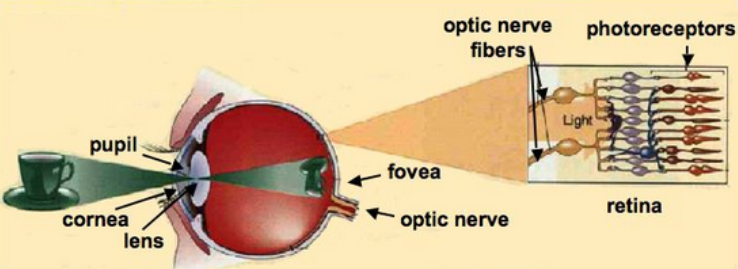
top-down and bottom-up processing
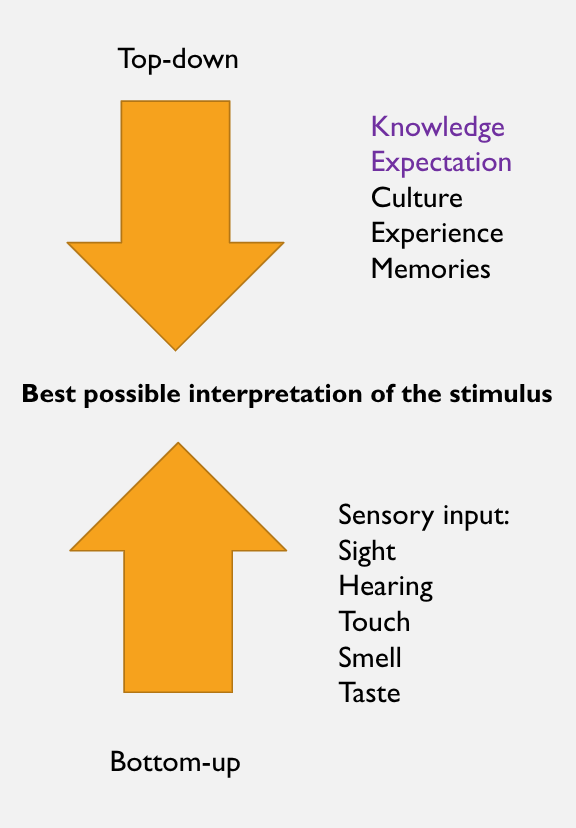
Examples of top-down processing
speech segmentation: speakers of a language can hear where one word ends and another begins even though the input is a continuous sound stream, knowledge creates the perception of individual words
pain perception is influenced by placebo. Expectation that the pain will be reduced leads to refocussing of attention to other things, which in turn leads to pain reduction
visual perception is influenced by memory and context
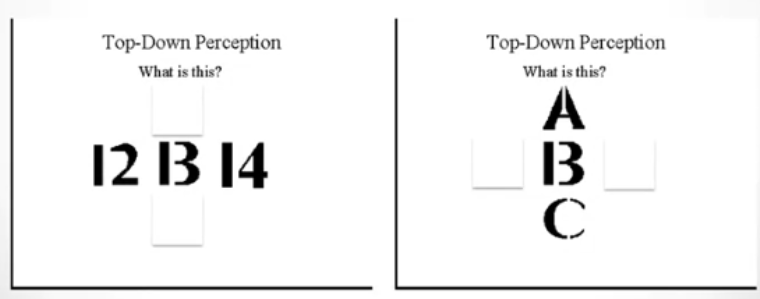
theories of object perception
Helmholtz theory of unconscious influence: a particular pattern of activation in the retina can be caused by a range of objects eg.
likelihood principle: we perceive the object that is most likely to have caused that pattern. This judgement is a result of unconscious assumptions (inferences) that we make about the environment and it happens ‘automatically’
we see objects in a 3D world. If there is a chance to interpret an object as 3D we do. Illusion shows that we don’t see 2D objects as they are (equal in size). Instead we see the 3D shape of the objects in space.
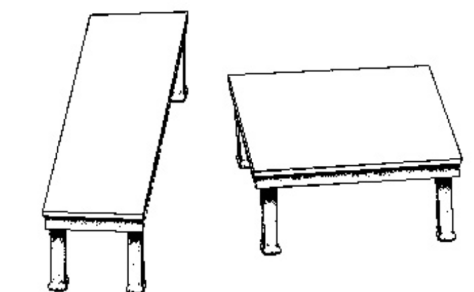
the Gestlat Principles (grouping)
Law of Similarity - similar things are grouped together. You see rows of dots rather than just a dot pattern.
Law of Pragnanz - this law holds that objects in the environment are seen in a way that makes them appear as simple as possible. You’d see an image of overlapping circles rather than an assortment of curved, connected lines
Law of Proximity - things that are near each other seem to be grouped together
Law of Continuity - the law of continuity holds that points that are connected by straight or curving lines are seen in a way that follows the smoothest path. Rather than seeing separate lines and angles, lines are seen as belonging together
Law of Closure - according to the law of closure, things are grouped together if they seem to complete some entity. Our brains often ignore contradictory information and fill in gaps in information.
Law of Common Fate - states that humans perceive visual elements that move in the same speed and/or direction as parts of a single stimulus
using these laws we have now grouped bits in the environment into bits that belong together, bits that are an entity, an object. The next step is for the brain to figure out is what is that object, what characteristics make it a member of that category of objects.
monocular cues of depth
perspective
occlusion - where something is hidden or obscured from prominence or view
shadow
monocular cues
occlusion, relative size, relative height, texture gradient, familiar size, linear perspective, aerial perspective, shading, motion parralax
arial perspective - because of the scattering of blue light in the atmosphere distant objects seem more blue (eg, mountains), on clear days the mountains seem closer; scattering of light also creates a blur, blurry things are further away, sharper contrast items seem closer
light and shade - we have the light-from-above assumption, perspective changes when the image is viewed upside down
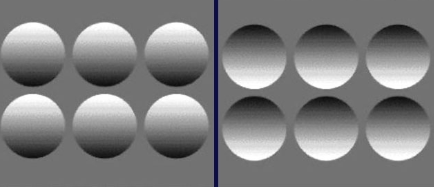
monocular movement parallax - when the head moves close objects move fast, distant objects move relatively slowly
BUT we have 2 eyes
binocular disparity - differences in the images of the two eyes
stereopsis - disparity transformation into perception of depth
why 2 eyes
convergence

overlapping visual fields enable stereoscopic visions by blending slightly dissimilar views of an object
allows us to see farther into the distance with higher resolution
the interaction of perception and action
is movement necessary to develop normal vision? Held & Hein, 1963
all active kittens developed a visually guided paw placement response after 63 sessions the latest (most had 33 sessions), none of the passive kittens had

all active kittens avoided deep end of glass cliff, passive kittens went randomly to deep and shallow side
self produced movement and concurrent visual feedback are essential for the development of visually guided behaviour
From perceiving what to perceiving where
data coming in from our eyes only means something when we can cross-reference it. We need feedback on what this information means. Hence, what we touch influences how we see.
cross cultural studies of perception
provides evidence that the way we perceive the world depends on what surrounds us
cultural influences due to factors eg environment, education, cultural history, language
Segall, Campbell and Herskovits (1963)
western cultures are more susceptible to the Muller-Lyer illusion and the Sander parralellogram illusion compared to cultures from rural Africa and the Phillipines

people who live in urban environment which contains more rectangular shapes are more prone to these (mistake lines as depth cues for distance)
people in rural areas experience more flat terrain and actual distance
Mayer & Rahmann (2018)
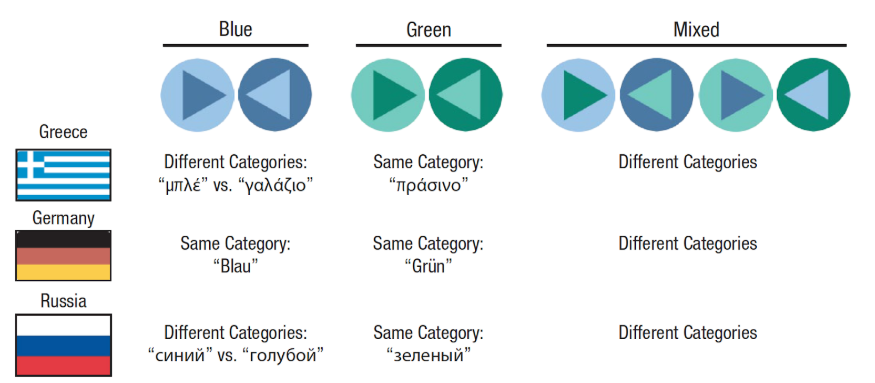
attentional blink paradigm where the second stimulus is difficult to process; Greek and Russian participants were better at discriminating the light from the dark blue stimulus (no difference for green) than German participants who performed the same for blue and green stimuli; light and dark blue have different names in Greek and Russian; native language influences our perception
colour vision
colour vision is affected by your native language. Other influencing factors are gender (many genes for colour vision are on the X chromosome making colour blindness more common in men); hormone levels also play a role and age (fades with age)
crossover in sensory modalities: synaesthesia
when presented with stimulation in one sensory modality, another modality is simultaneously activated; a blending of the senses occurs
components of memory
memory: process involved in retaining, retrieving and using information of the past which affects the present, possibly the future
the memory storage model eg Atkinson and Shiffrin (1968)
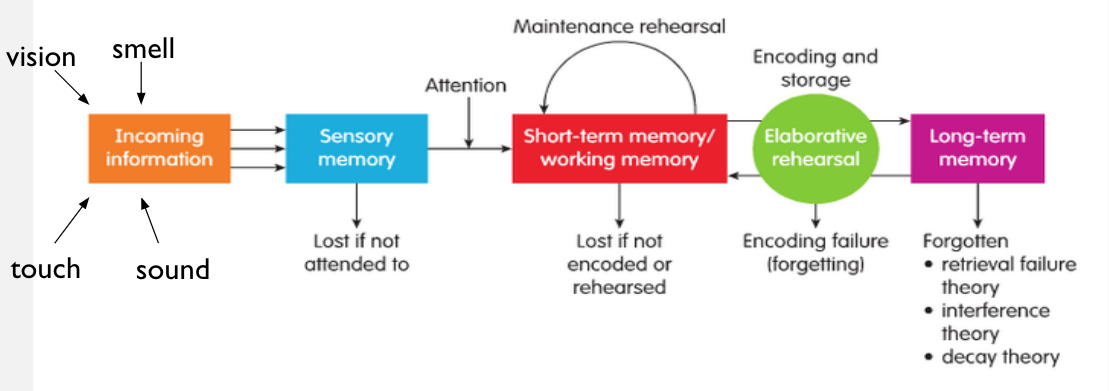
sensory inputs persists very briefly, passively, in modality-specific temporary buffers (‘iconic’ memory for vision, ‘echoic’ memory for audition, etc)
only attended items are identified and represented in a short term store (STS), where they can be operated upon, used to initiate/guide action or transferred (by rehearsal) into long term storage (control processes required)
STS capacity is very limited: contents decay or are overwritten/displaced by new input or by information retrieved from long-term storage unless deliberately maintained by rehearsal
short term/working memory - Baddeley and Hitch, 1974
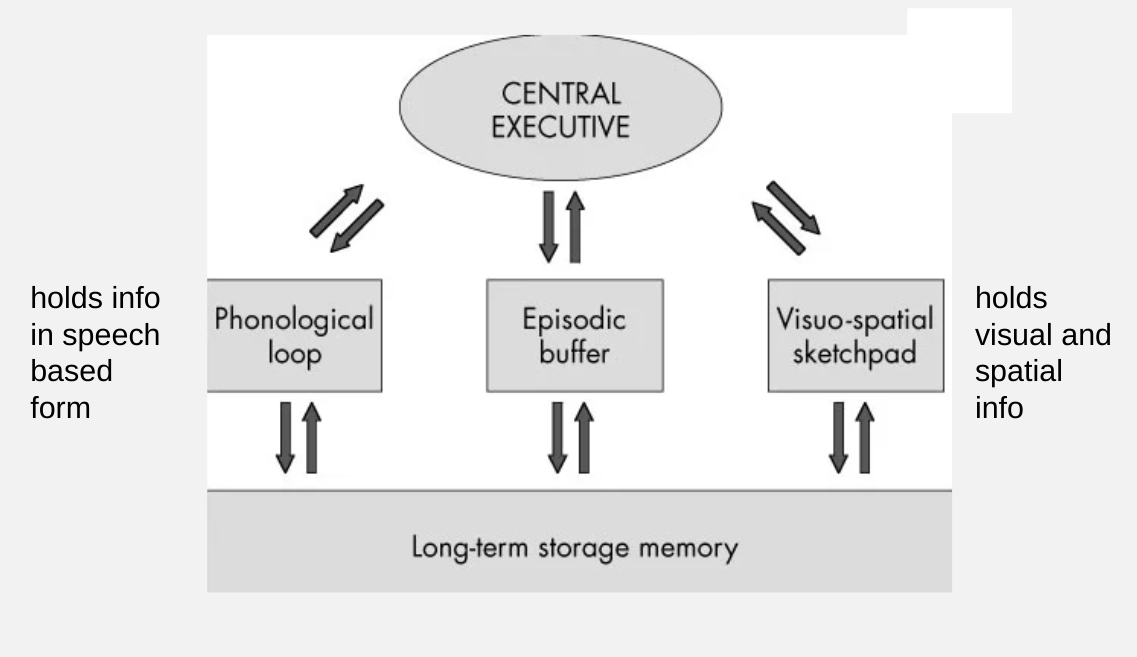
components of long term memory
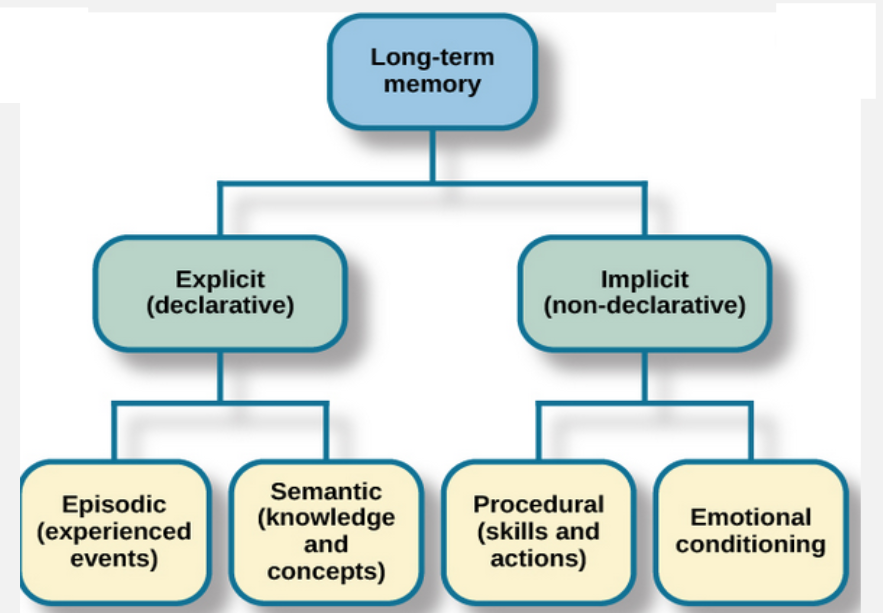
three reasons (a priori) for posting that working memory and long-term memory are separate
introspection: ‘primary’ vs ‘secondary’ memory (James, 1890)
physiology:
info stored in current neural activity vs changes in synaptic strength
something most hold new information during initial ‘consolidation’ into longer term memory (requires protein synthesis)
reverberating circuits? (Hebb’s 1949 ‘cell assemblies’
cells in monkey prefrontal cortex show sustained activation in delayed-response and delayed match-to-sample tests
complex information processing systems (eg computers) use temporary ‘work spaces’
to keep information being operated on readily available
to temporarily store information that is not worth storing permanently
working memory aka primary memory, short term storage (STS), ‘active’ memory
arguments that working memory is distinct from long term memory come from
introspection
physiology
consideration of computational utility
experiments on normal subjects
effects of brain damage
to test whether our minds do have this type of temporal storage we need tasks that measure memory for very recent information
measuring short-term forgetting
The ‘brown-peterson’ distraction paradigm
participant reads a short list (of 3 words/letters in this example), tries to retain it while eg counting backwards by threes, until cued to recall
retention interval varies from trial to trial
retention rapidly declines over time, then levels off: two memory components?
Free recall
S sees/hears a long sequence of items
at the end of the list tries to recall as many as possible in any order. If one asks to recall the last items first, they are relatively well remembered (recency effect)
explaining the pattern of short term forgetting
single trace theory: memory trace decays rapidly to start with, then more slowly
dual trace theory: retrieval after short interval mediated by temporary rapidly-decaying memory trace; retrieval after longer interval mediated by a more permanent memory trace
the dual trace theory would be supported by:
retention over a short interval influenced by factors that don’t influence retention over a long interval (factor A)
retention over a long interval influenced by factors that don’t influence retention over a short interval (factor B)
‘double dissociation’ between the effects of factors A and B
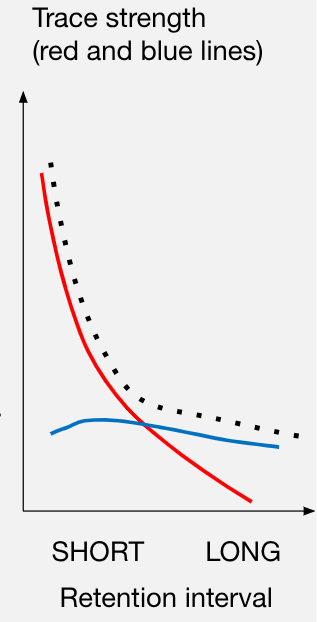
factors selectively impacting free recall
list length: the longer the list the fewer items are recalled BUT recency effect is unchanged
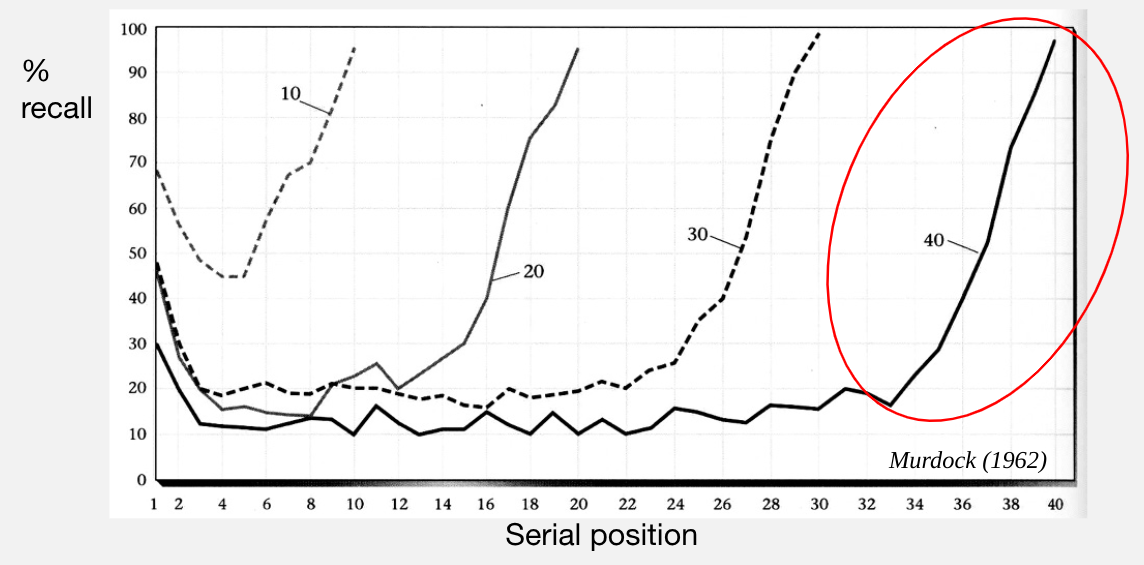
Glanzer & Cunitz (1966)
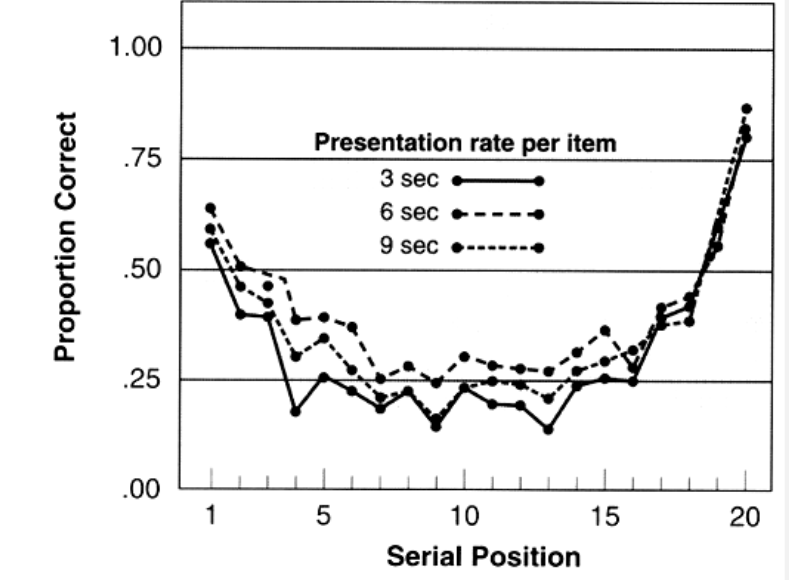
faster presentation rate reduces recall of items presented earlier
but not of the recent items
Same for: longer list, old age, alcohol
so far, a single dissociation : consistent with a single memory trace whose decay rate is changed by these manipulations. Double dissociation needed (ie a manipulation that zaps recall of recent, not earlier, items)
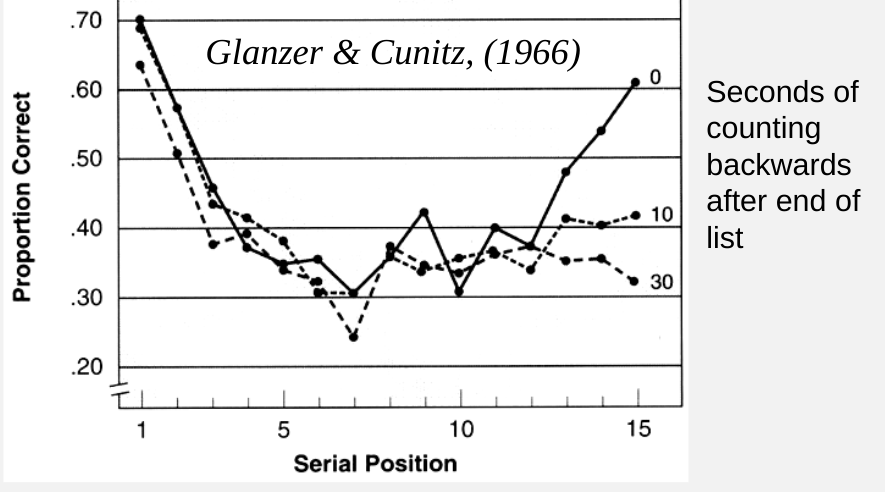
counting backwards after the end of the list eliminates the recency effect, but does not influence the probability of recall of early items
double dissociation
so, recall of last few items mediated by a memory trace rapidly lost in the absence of rehearsal
earlier items recovered (if it all) from a different, more permanent trace
recap: components of memory part 1
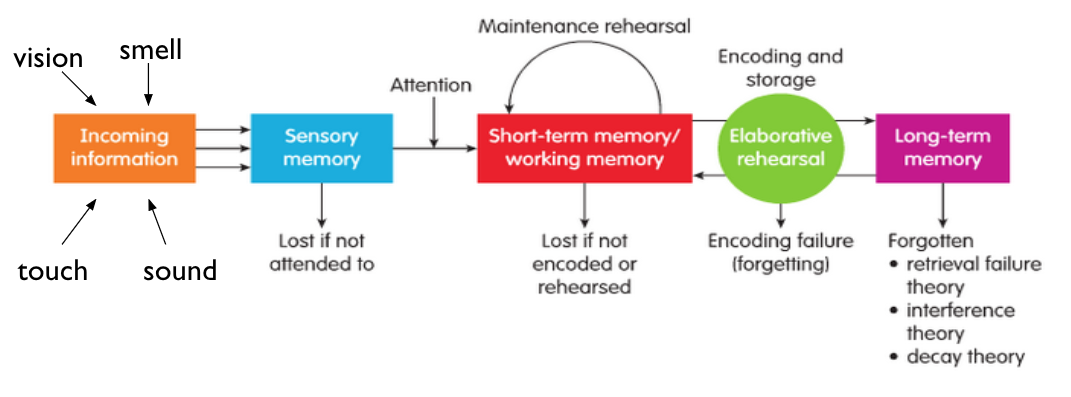
double dissociations between short term and long term memory (disturbing the recency effect - STM, disturbing effects on items presented earlier - LTM)
visuo-spatial memory
how do we know there are distinct memory stores?
vision
→ iconic sensory memory
→ visual short-term memory
→ visual long term memory
Partial report of brief displays (Sperling, 1960)
briefly flash 12 letters, 3 rows - have to write down as many as you can
4 correct is typical
people say that they can briefly see all the letters as visual objects: they just don’t have time to identify more than about 4, before the image is gone. So, it seems visual sensory memory can hold about 4 items.
same thing repeated, but row is specified
people tend to get 3 or 4 right. As researcher could have cued you to look at any row, and there are 3 rows, we can estimate from the accuracy of your partial report that something like 10-12 items were (in principle) available
Sperling’s ‘partial report’ superiority effect
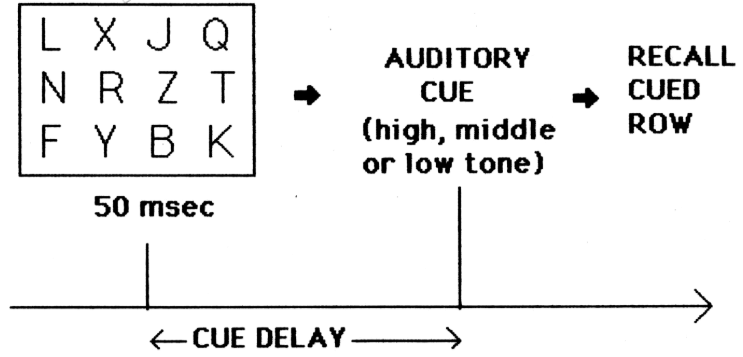
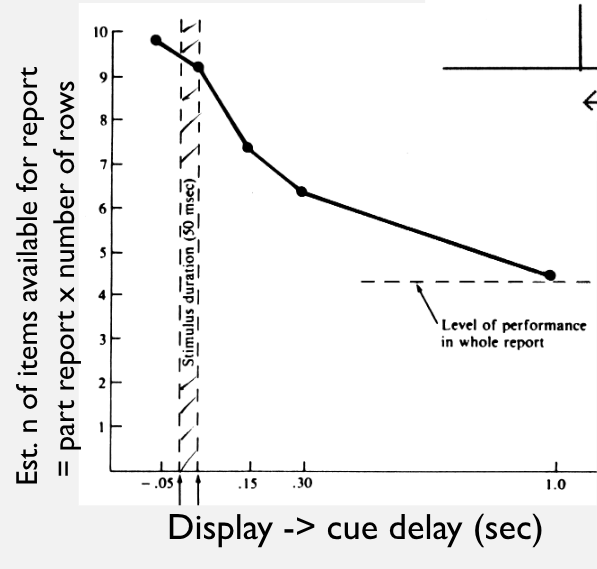
report of whole array poor (3-4 items)
cued report of single row good (3-4 items)
why the difference? for the whole report it takes time to say all the letters and after about ~1sec the sensory memory is lost
reporting the single row is quick, but the ‘partial report superiority’ is also lost when the cue comes after 1 sec, same reason, sensory memory trace has faded
change detection experiments with non-linguistic spatial arrays (Phillips, 1974)
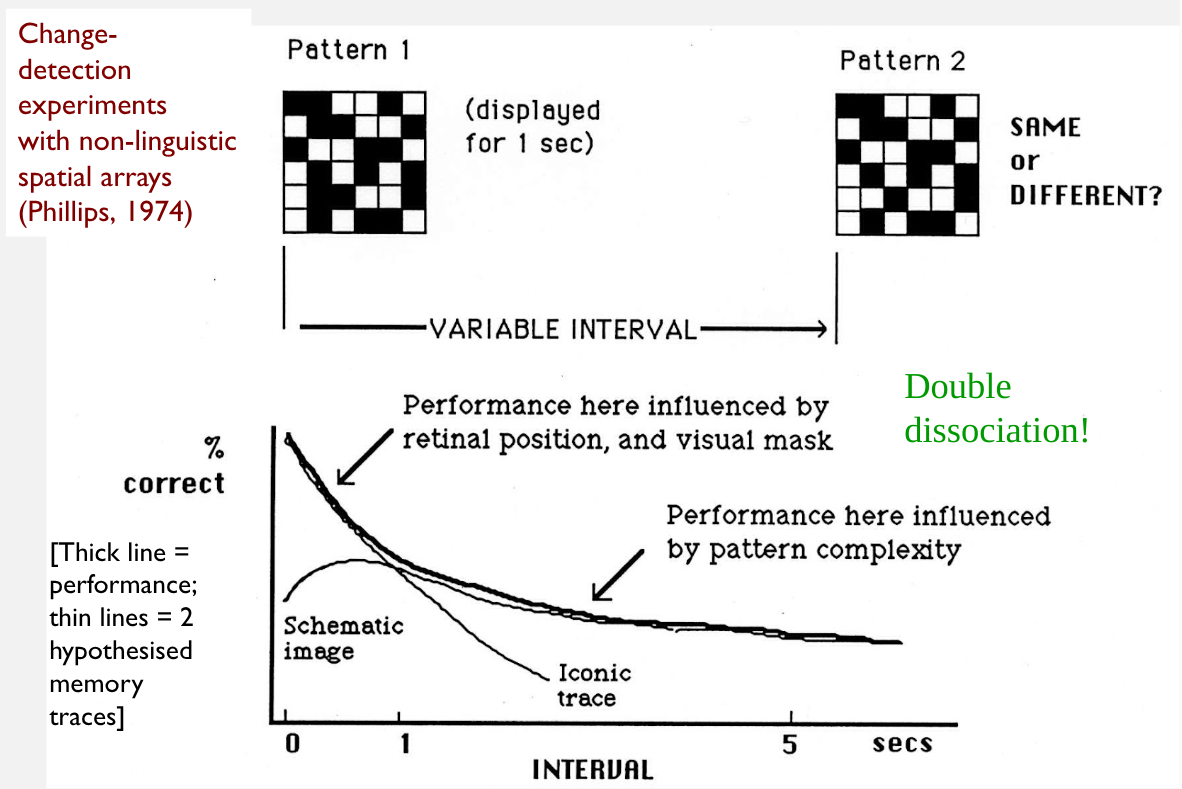
visual working memory and change detection

brief interpolated blank frame produces transients all over the visual field: attention no longer automatically attracted to region of change
now the only way to detect a change is to compare the present display with memory for the objects in the previous frame
under these conditions we don’t easily detect changes - unless we happen to have just attended the region of the change
→ very limited memory for the objects in the previous frame: ‘change blindness’ (Resinck, O’regan & Clark, 1977)
change blindness and the transition from iconic to visual working memory (VSTS)
different attributes (shape, colour etc) of objects presently in the visual field are represented by local activity in several visual cortex ‘maps’: separate maps for features such as orientation, movement, colour
this sensory activity persists beyond the stimulus offset (sensory memory) unless overwritten by a new retinal image, but not for long
while it remains available, binding features by focal attention creates ‘object files’ in visual working memory (or VSTS)
unless you have attended to an object in the previous frame and its file is made it into visual working memory (VSTS), you won’t detect the change
how many objects can VSTM hold?

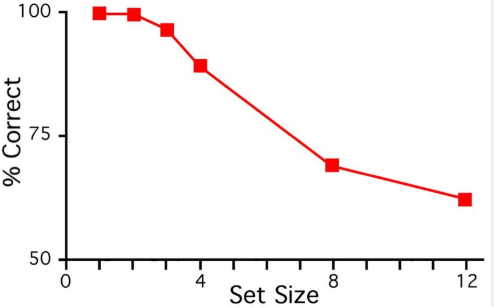
vary number of objects in ‘one-shot’ change detection task
only about 3 or 4!
is visual STM distinct from long term visual memory?
sequence of 8 Phillips checkerboards, followed by a sequence of test checkerboards same as/different to each pattern in the first sequence, but in reverse order
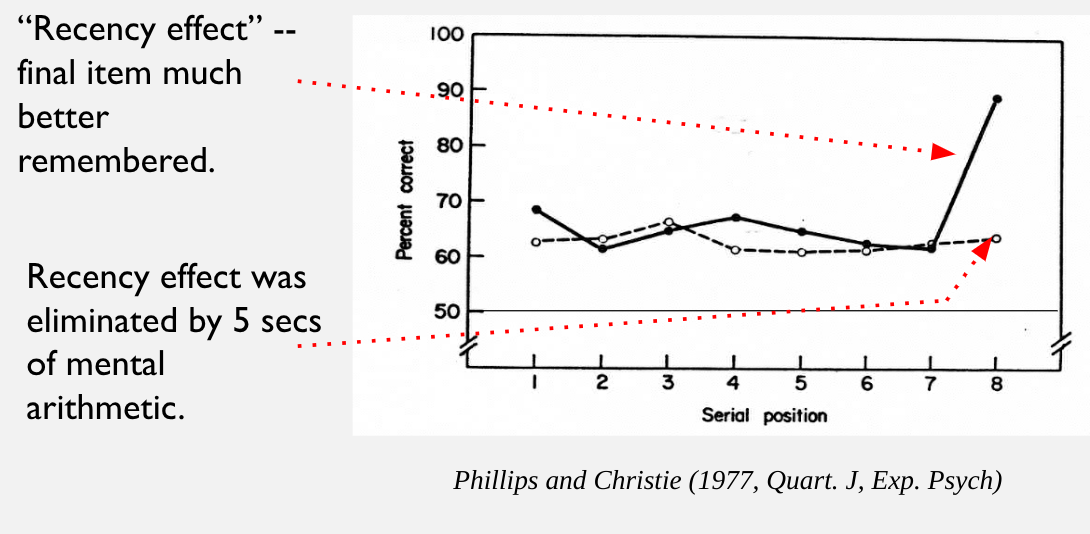
‘recency effect’ - final item much better remembered
recency effect was eliminated by 5 secs of mental arithmetic
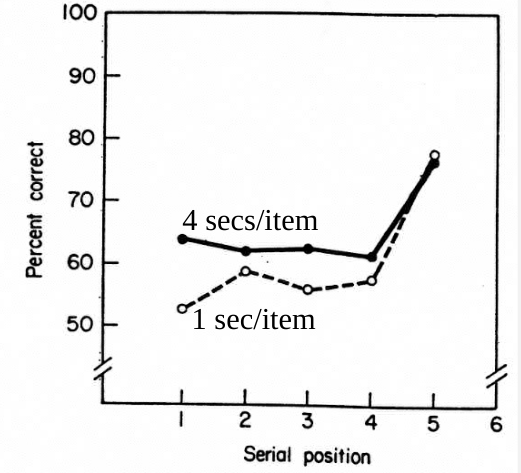
slower presentation rate improved memory for all but the last item
double dissociation
so, the most recent complex array seen is held in visual STS
previous patterns recovered (if it all) from distinct long-term visual memory
summary: memory so far
behavioural evidence that there are distinct stores for working memory and long-term memory
is this true for all sensory information?
we looked at the case of vision: distinctions between iconic sensory memory, visual short term memory and visual long term memory